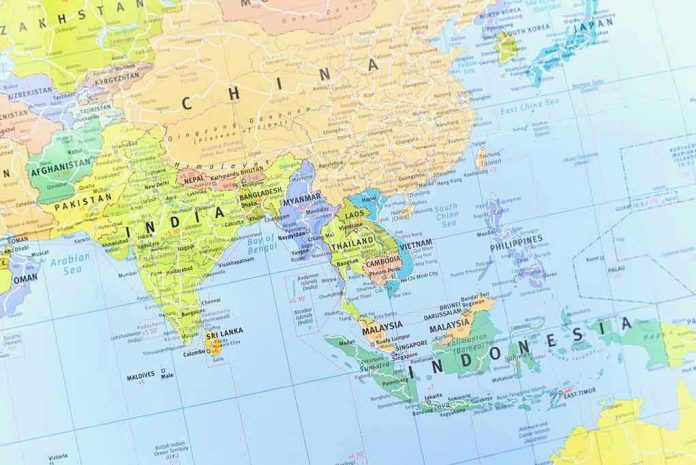
China’s aggressive maritime bullying backfired spectacularly when two Chinese warships collided with each other while harassing a Philippine Coast Guard vessel, exposing the reckless incompetence behind Beijing’s South China Sea intimidation tactics.
Story Highlights
- Chinese Coast Guard cutter CCG 3104 slammed into PLAN destroyer Guilin during high-speed harassment of Philippine vessel
- CCG ship suffered severe bow damage and became unseaworthy after botched aggressive maneuver
- Incident captured on video by targeted Philippine Coast Guard crew near Scarborough Shoal
- Philippine officials blame Chinese miscalculation and dangerous seamanship for embarrassing collision
Chinese Ships Collide During Botched Harassment Operation
China Coast Guard cutter CCG 3104 crashed into People’s Liberation Army Navy destroyer Guilin while aggressively pursuing Philippine Coast Guard vessel BRP Suluan near Scarborough Shoal on August 11, 2025. The collision occurred approximately 10.5 nautical miles east of the disputed shoal as Philippine personnel distributed aid to local fishermen. Video footage released by the Philippine Coast Guard shows the dramatic moment when the Chinese cutter’s reckless high-speed maneuver resulted in catastrophic damage to its own bow section.
Dangerous Coordination Failures Expose Chinese Maritime Incompetence
The collision sequence reveals alarming coordination failures between Chinese maritime forces operating in close quarters. CCG 3104 was water-cannoning the Philippine vessel while the PLAN destroyer Guilin crossed perpendicular to the stern of BRP Suluan in a “boxing-in” maneuver. When the coast guard cutter made a sharp starboard turn at high speed, it slammed directly into the destroyer’s port bow, removing the CCG vessel’s entire forecastle section and scraping the warship’s hull.
Philippine Strategy of Documentation Pays Dividends
Philippine Coast Guard spokesperson Commodore Jay Tarriela characterized the incident as a “risky maneuver” and “miscalculation” by Chinese forces, urging adherence to international collision-avoidance rules. The Philippines’ systematic documentation and publication of Chinese harassment incidents continues building international support while exposing the dangerous nature of Beijing’s gray-zone tactics. This embarrassing self-inflicted damage undermines China’s projection of maritime dominance in disputed waters that rightfully belong within the Philippines’ exclusive economic zone.
Broader Implications for Regional Maritime Security
The collision highlights the escalating risks of China’s increasingly aggressive maritime coercion campaign throughout the South China Sea. Since 2023, Chinese forces have intensified water-cannoning, ramming, and blocking tactics against Philippine vessels conducting legitimate operations in their own territorial waters. This incident exposes how Beijing’s pressure-cooker tactics create dangerous conditions where their own forces become casualties of their aggressive overreach, potentially leading to more serious escalation scenarios involving casualties or environmental damage.
Terrific! Chinese Ships Collide While Harassing Philippine Coast Guard #China https://t.co/sjNpktHKL6
— Derek (@derekdob) August 11, 2025
The CCG 3104 remains out of action pending extensive repairs while the PLAN destroyer suffered visible hull damage. No casualties were reported, but the incident reinforces concerns about Chinese disregard for international maritime safety standards and collision-avoidance protocols. As China continues its illegal occupation and harassment operations around Scarborough Shoal, this self-inflicted embarrassment demonstrates the operational risks inherent in Beijing’s dangerous approach to territorial disputes.
Sources:
Chinese ships slam into each other while chasing Philippine vessel
Chinese Destroyer Rips Bow Off Chinese Coast Guard Cutter During Intense Harassing Maneuvers
Chinese vessels collide during pursuit of Philippine boat in South China Sea







